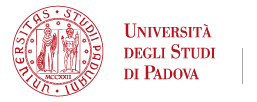

FRANCESCA CIMA
Title: Professore associato
SSD: BIO/06 - Comparative Anatomy and Citology
Address: VIA U. BASSI, 58/B - PADOVA
Phone: 0498276198
E-mail: francesca.cima@unipd.it
Curriculum
Prof Francesca Cima is Associate Professor of "Comparative Anatomy, Cell Biology and Developmental Biology" at the Department of Biology (DiBio), University of Padova.
In 1990, she had a degree in Natural Sciences at the University of Padova with full marks cum laude. In 1991, she was admitted as PhD student of Evolutionary Biology at the University of Padova and, in 1994, achieved the PhD qualification with her dissertation "Haemocytes and immunity in the colonial ascidian Botryllus schlosseri". From 1996 to 1998, she obtained a two-year postdoctoral fellowship concerning the research field "Evolutionary Biology" in the Department of Biology. She was awarded the "Paolo Gatto's national prize" of the Accademia Nazionale dei Lincei regarding environmental problems of the Lagoon of Venice. From 1999 to 2001, she obtained a two-year research collaboration fellowship in the project entitled "Differentiation and cell interactions in Tunicates" with a further two-year renewal. In 2000, she was the Scientific Chief of the Research Project for Young Researchers entitled "Development of new bioindicators and biomarkers for the study of environmental impact by organotin compounds on coastal ecosystems". In 2001, she obtained a master in "Microscope analysis techniques in biological sciences" at the University of Pavia. From 2005 to 2018 she was Assistant Professor in "Comparative Anatomy and Citology" at the Department of Biology, University of Padova. Since 2019, she is Associate Professor and teaches the courses of "Cell Biology" and "Evolutionary History of Vertebrates" for the first degree in Biology, and "Principles of Animal Biology" for the first degree in Natural and Environmental Sciences.
She is a member of Italian Zoological Union, Italian Embryological Group, Italian Association of Naturalists, Natural Sciences Society of Trentino, Italian Society of Comparative and Developmental Immunobiology, Society for Histochemistry, and Italian Society of Histochemistry, of which she was a member of the management board in 2018-2021. She has been advisory board member of international journals such as "Applied Organometallic Chemistry" (ISSN:1099-0739, Wiley & Sons Ltd, Prof PJ Craig General Editor), "European Journal of Histochemistry" (ISSN: 1121-760X, PAGEPress; Editor in Chief: C. Pellicciari), and "Journal of Marine Science and Engineering" (ISSN: 2077-1312; Editor in Chief: Prof. T. Clare). Her research activity is documented by more than 200 in extenso scientific publications, contributions to international congresses, contributions to national congresses, book chapters; she is also author of 1 monograph, 2 book editings, 1 English-to-Italian translated book chapter.
Research area
1. COMPARATIVE IMMUNOBIOLOGY OF MARINE INVERTEBRATES (TUNICATES, BIVALVES, SIPUNCULA)
a) Haemocyte lines, innate immunity, and immunesurveillance in marine invertebrates
b) Evolution of the immune system in chordates
2. DEVELOPMENTAL BIOLOGY AND COMPARATIVE ANATOMY
a) Apoptosis and colonial cycle in the ascidian Botryllus schlosseri
b) Morpho-functional aspects of the alimentary canal of Ascidians, Thaliaceans and Appendicularians
c) Spermatogenesis in Appendicularians
3. ECOTOXICOLOGY IN MARINE INVERTEBRATES
a) Immunotoxicity and bioaccumulation of antifouling compounds in coastal marine invertebrates used as bioindicators (ascidians, bivalves, sea urchins, sipunculans, soft corals)
b) Embryotoxicity and alterations of larval development by antifouling compounds on marine invertebrates
c) Effects of physical (i.e., ultrasound, geotextiles) and chemical (i.e., antifouling paints and biocides) antifouling systems on both single species of marine invertebrates and ecological succession of the hard-substratum macrofouling community in the coastal marine ecosystems.
Proposals for thesis
COMPILATIONAL AND EXPERIMENTAL THESES on various topics:
1. EVOLUTIONARY HISTORY OF VERTEBRATES (only for students who have attended the relevant course): a topic of the student's choice, to be agreed with the teacher, for a compilational thesis or an activity in collaboration with the Museum of Nature and Mankind (MUSNA), Vertebrate Palaeontology Section, for an experimental thesis.
2. EVOLUTION OF THE IMMUNE SYSTEM FROM NON-VERTEBRATES TO VERTEBRATES: study of multiple aspects of immune defence responses in Bivalve Molluscs (protostomes) and Tunicates (deuterostomes), the latter being important models representing the sister group of Vertebrates.
3. ECOTOXICOLOGY OF ANTIFOULING SYSTEMS IN COASTAL MARINE ENVIRONMENTS: analysis of the high toxicity of biocide compounds in antifouling paints and of the impact of physical antifouling systems (e.g. ultrasound) on non-target benthic marine invertebrates, with evaluation of the potential severe effects on the biodiversity of coastal marine ecosystems.
4. RESTORATION AND CATALOGUATION OF THE BIOLOGY DEPARTMENT'S VERTEBRATE COLLECTIONS: students will learn the main techniques of conservation, display, restoration and cataloguing of vertebrates in relation to taxidermied, liquid-preserved, osteological and fossil replicate preparations. Patience, methodicality, order, resourcefulness and a good dose of creativity are required.
Last update: 14/10/2025





